Learn how to make Thai sticky rice in a bamboo steamer, traditionally using a steamer pot and a bamboo steamer basket. This method is the aged-old, proven, and true method that Thai people have used in Thailand for generations. Master the art of making this iconic rice that is popular worldwide!
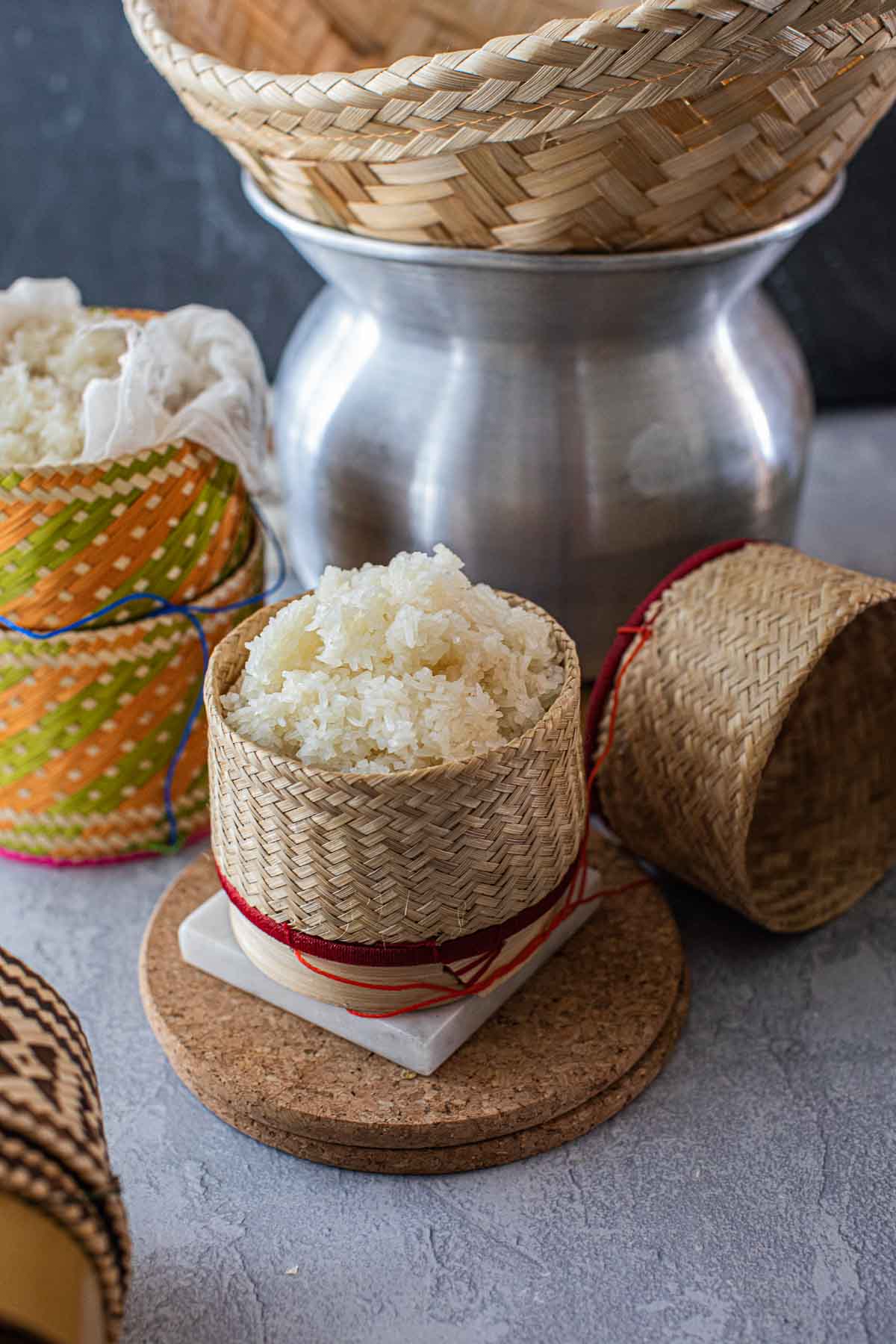
I’ve been eating sticky rice since I could walk, watching my mom and other families in my village prepare it daily. Now, I love teaching cooking classes on how to make sticky rice, and I still steam up a batch at home almost every week.
Jump to:
- Why you'll love making Sticky Rice
- What is sticky rice?
- Thai Sticky Rice ingredients
- How to make Sticky Rice (Thai)
- Tips for Making Sticky Rice
- Recipes using Steamed Sticky Rice
- What to serve with Thai Sticky Rice
- Sticky Rice Thai variations
- How to store Steamed Sticky Rice
- Frequently Asked Questions
- More Thai savory dishes you'll love
- Sticky Rice Bamboo Steamer Recipe
Why you'll love making Sticky Rice
- Sticky rice is fun to eat! Once cooked, sticky rice grains stick together like glue and can be rolled into small balls and eaten with your fingers!
- Steamed sticky rice is perfect for making and eating with kids!
- Easy to make! Though it may seem complicated to make (it's not). We need a little instruction and preparation, and you'll be on your way to making the perfect sticky rice every time.
- They are versatile and can be eaten with many light dishes! They are great with salads, grilled meat, as a side dish, or for use with dipping sauce.
What is sticky rice?
Sticky rice is a Thai glutinous long-grain white rice used extensively in Thai, Laos, Cambodia, and other Asian countries. Once cooked, the rice grains expand and soften, and they have a sticky texture that glues the grains together, and they can be rolled into little balls to eat with your fingers.
The Origin and History of sticky rice
Sticky rice is delicious rice from Laos, then Northern Thailand, and trickled down to Thailand Isaan region (Northeast) of Thailand. Now, it's being eaten and enjoyed throughout Southeast Asia and beyond.
Sticky rice farming
Sticky rice is an important rice in Thai and Laos cuisine. It's the staple rice and the preferred rice over Thai jasmine rice. Due to the arid temperature of the Northeast of Thailand, crops are hard to grow there. Sticky rice, however, doesn't require as much water as Jasmine rice, making it an easy crop for Thai farmers to grow. So sticky rice became more popular than Jasmine rice in the dry region of Thailand.
Sticky rice in Thailand
Like many Thai dishes, especially those famed dishes from Northeastern Thailand, sticky rice is believed to have its origin in Laos. Its popularity of it trickled down Northern Thailand. Then it became the main staple in many provinces in the Isaan region of Thailand, where food is very similar to Laos food.
In Thailand, sticky rice is the main rice in Northern Thai food and the Northeast of Thailand. However, many Asian countries also cook with glutinous Thai rice and use it in various recipes.
Thai Sticky Rice ingredients
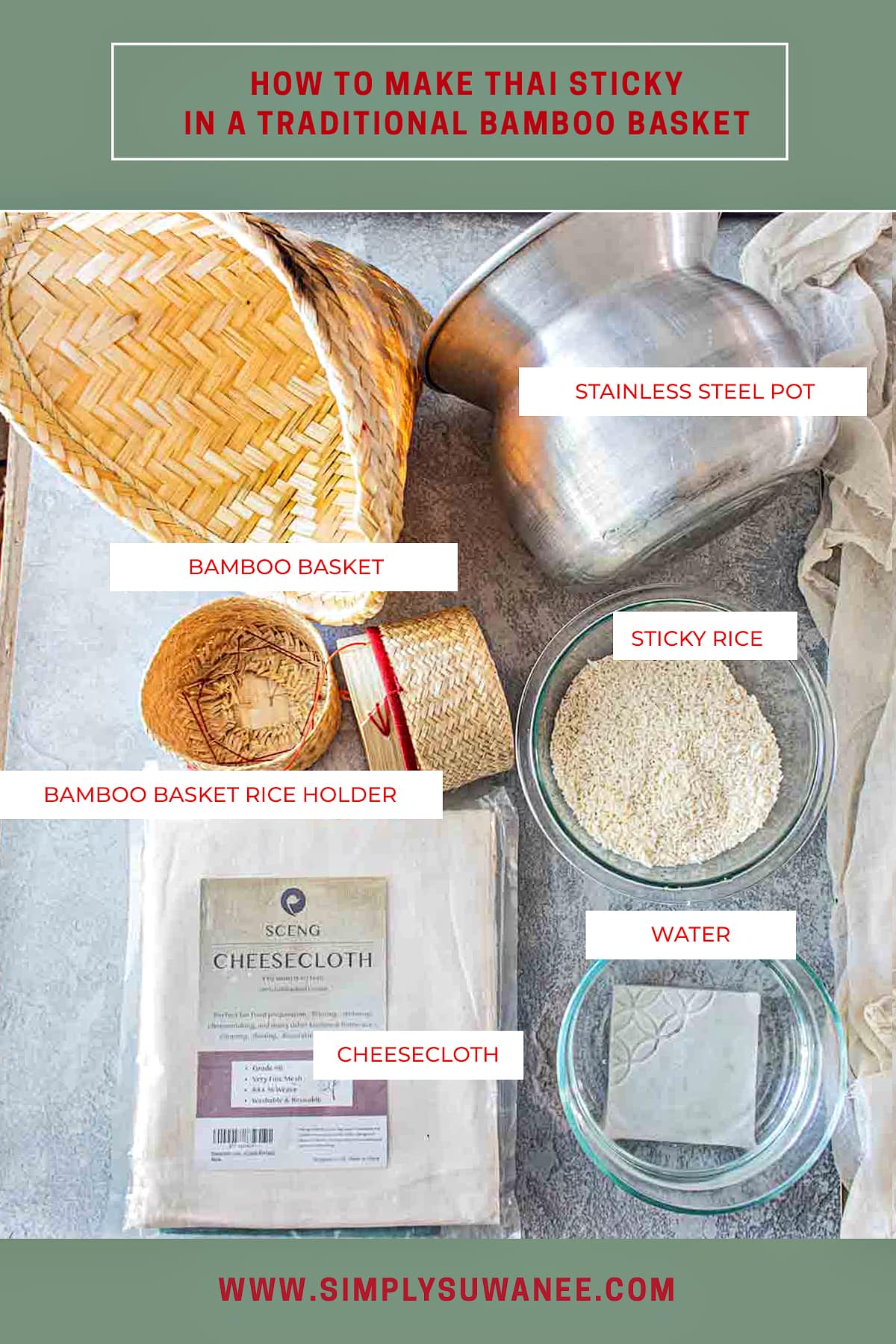
- Sticky rice. The most important ingredient for this recipe. Find these at your local Asian market. See the section on the many names of sticky rice to ensure you get the right rice.
- Water. You will need water for rinsing, soaking, and steaming the sticky rice.
- Salt. Optional for sprinkling on the rice at the end when rice is finished cooking.
Picking the right rice
Making sticky rice starts with picking the correct rice for the job! See the section on the many names of sticky rice you may come across when buying rice. They are sold in most Asian markets. They come in different sizes ranging from a smaller 5-pound bag to a large 50-pound sack. The bags are usually labeled "Sweet Rice" or "Glutenous Rice." See the picture below.
Tools needed for Bamboo Sticky Rice
You'll need special equipment to make sticky rice this way. The special apparatus set is the traditional way of making sticky rice, and you'll be delighted with the perfect result every single time.
- Wooden spatula
- Conical bamboo basket set
- A bamboo lid for steaming sticky rice. Optional (but extra cute!)
- Bamboo sticky rice basket holders
- The metal steamer works great as a substitute for steaming sticky rice
- Cheesecloth
Should you buy a traditional Sticky rice bamboo basket?
The tool can deter people from buying it since it can be bulky. You may not want to add another kitchen tool to your space. If you are on the fence and need a good reason to own one. Read on below. You should invest in a set if you can check more than 3 bullet points below! (:
- You cook Thai food a lot and love sticky rice. If you are a huge Thai food fan, buy the set, you'll be legit, approved upon arrival by your guests at seeing the set on your stove! Especially your Southeast Asian friends. Hehe!
- If you love entertaining guests or hosting dinner parties with good Thai food. They are great for use when making a large batch of Sticky rice to serve guests.
- Want to make perfect sticky rice every time you make it? This method of cooking sticky rice has been around for generations, and it's been trial and true, and it's hard to go wrong making sticky rice with this traditional way of doing it.
- You eat rice or sticky rice more than 2 times per week. If you love sticky rice so much, you must own this set. It's just worth it.
- If you have good space to store or showcase a set. They are iconic and are becoming more of an art piece by the decade. Use it as a decorative piece on a shelf when not used for cooking.
- You have an Asian market near you, and they offer Thai or Southeast Asian tools. Sometimes, Thai bamboo basket sets can be hard to come by in some cities. If you can find a smaller set, get those that aren't as chunky as the bigger one.
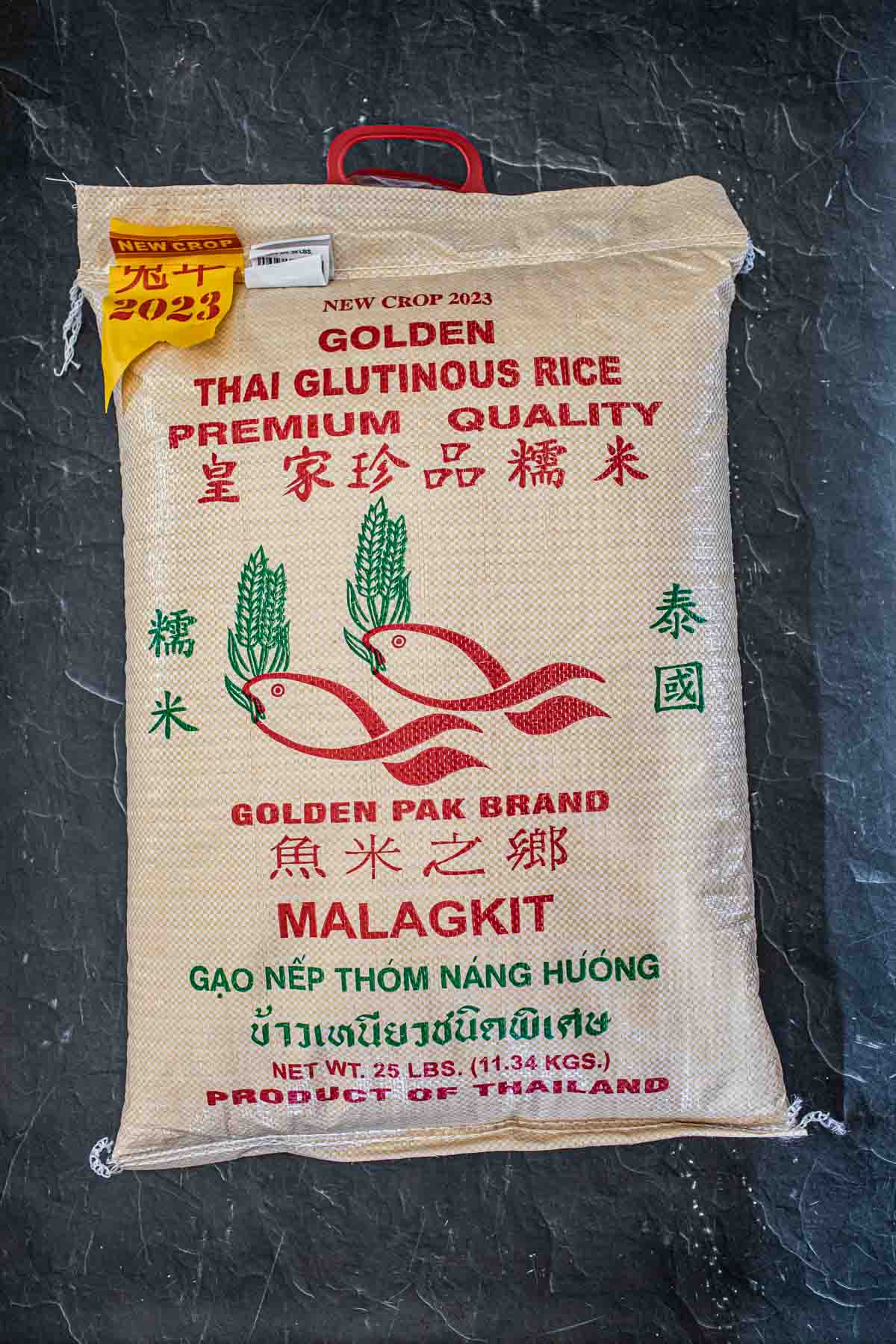
How to make Sticky Rice (Thai)
Below, I will teach you how to cook delicious Thai Sticky Rice the old traditional way. This is how I grew up making sticky rice, and it's been how I've made it for decades. There are various ways to cook sticky rice, but this is the best way, in my opinion! The cooking process is quite simple.
The planning process takes a tiny bit of thinking and planning. After you've mastered the concept, cooking delicious Thai sticky rice will take you no time. The long hours of soaking is what take a bit of time. It's important to note that the rice is steamed, NOT cooked directly with water like regular rice.
Let's get started!
Step 1. First thing first. Wash the sticky rice. In a mixing bowl, add the rice and cool water to wash and rinse. Use your fingers to swoosh the rice grains in the water to help loosen up the grains and starch. Your water will be cloudy, milky water. Rinse the water out and repeat this step 4-5 times until your water is mostly clear. Use a strainer or splatter guard to catch the rice grains when pouring if you don't want to lose rice grains.
Soak the rice in cold water for a minimum of 5 hours at room temperature up to overnight for the best result. No longer than 24 hours. See the note below for more kitchen tips.
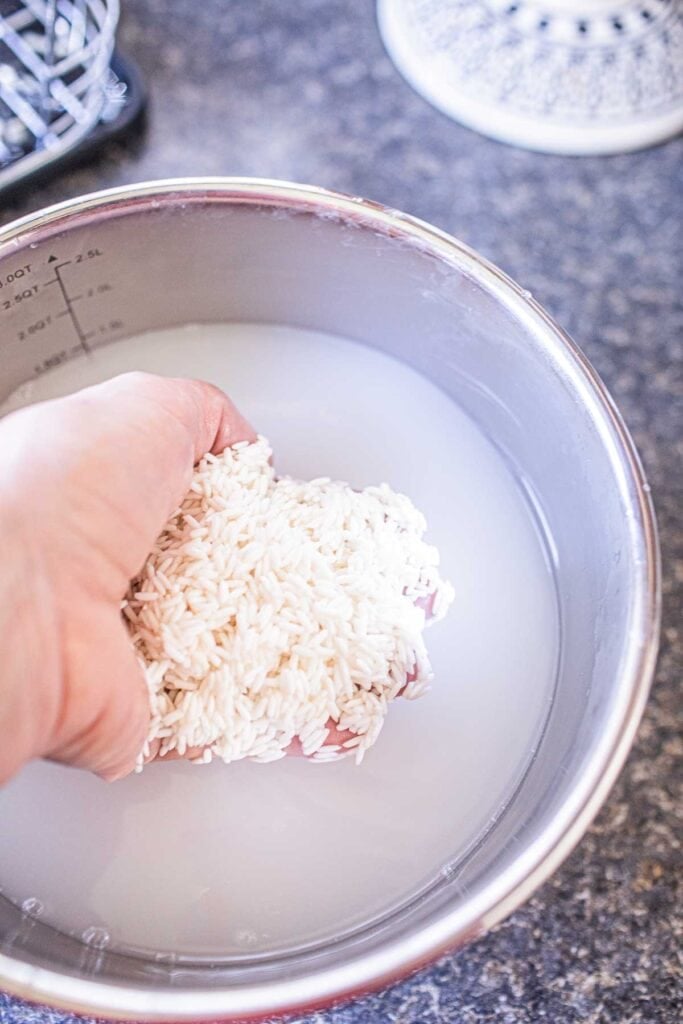
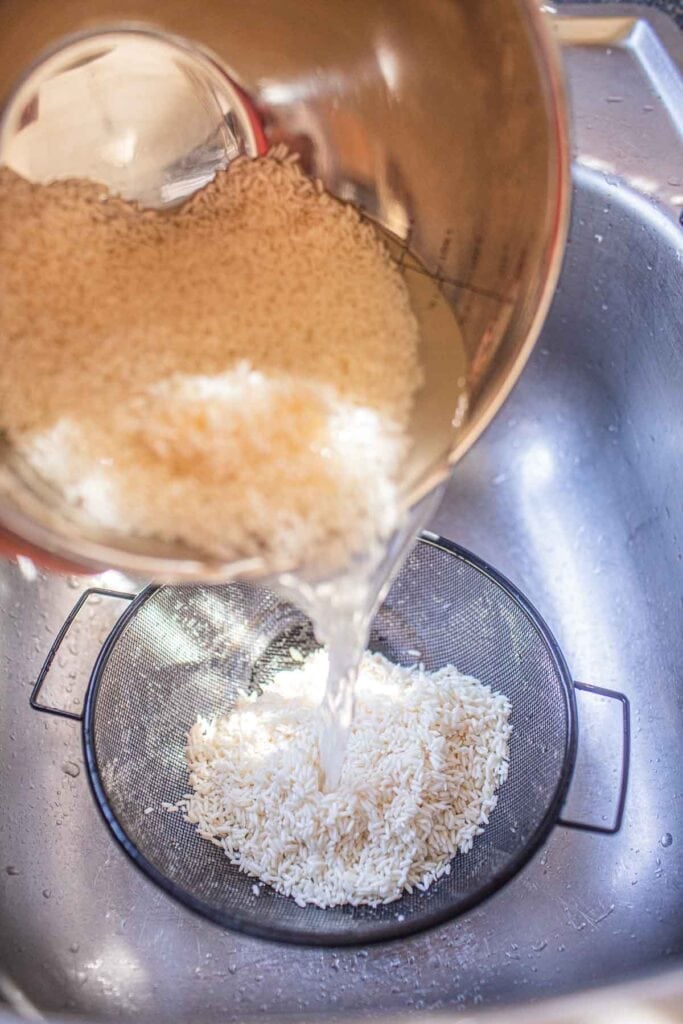
Step 2. We'll steam the rice the next day or a few hours later. Fill the bottom of the steamer pot with enough water to steam rice for up to 20-25 minutes without the water drying out. So anywhere from 8-12 cups, depending on the size of your pot. The large pot will require more water and also cooking time.
The water level should be low enough not to let the bottom of the bamboo basket touch it. Allow at least 2 inches of space between the water and the bamboo basket.
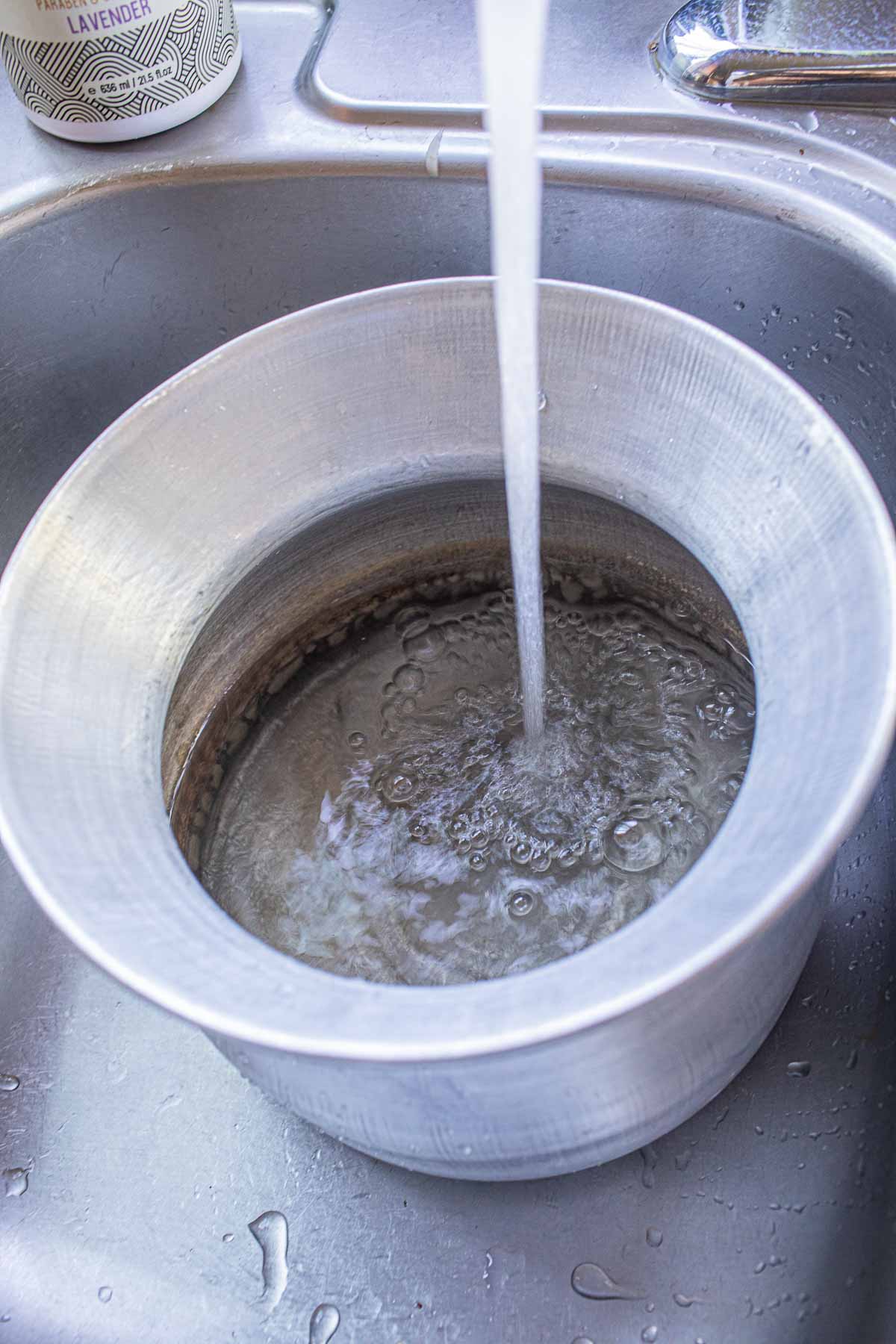
Step 3. Wash, drain, and rinse the soaked rice before steaming. Then line the bamboo basket with cheesecloth, and place the rinsed rice over the cloth. Wrap the cheesecloth around the rice grains, place the basket over the stainless steel pot then cover it with a lid before steaming.
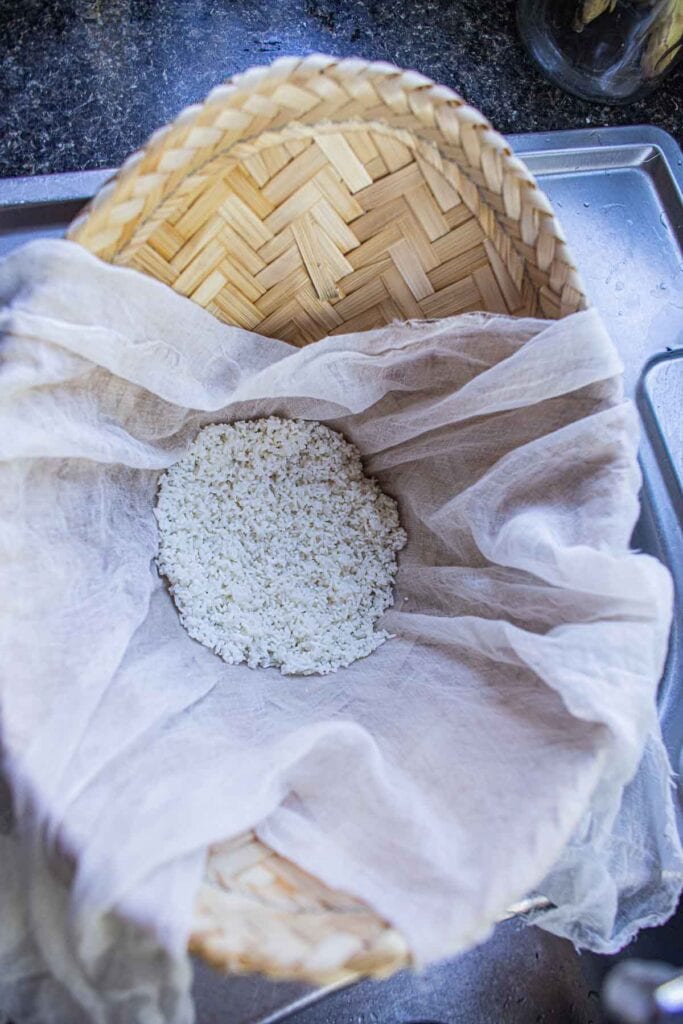
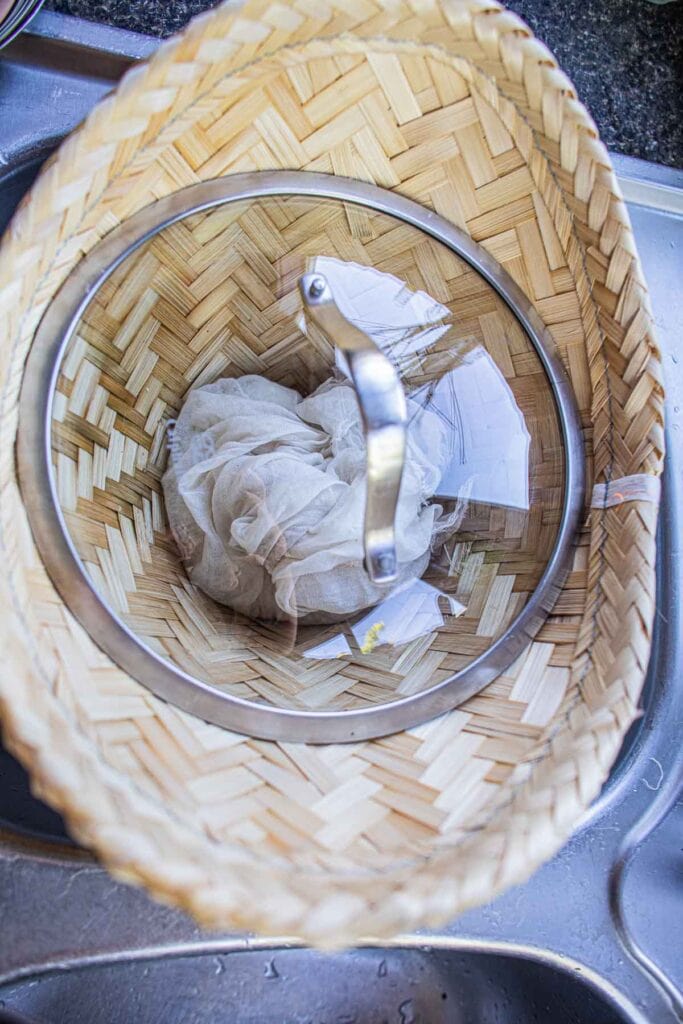
Step 4. Place the stainless steel with water inside and the cheese-clothe-covered rice in the bamboo basket. Turn the stovetop to high heat and cook for 15-20 minutes. It takes longer if you soak your rice for 5 hours or less. (20-25 minutes).
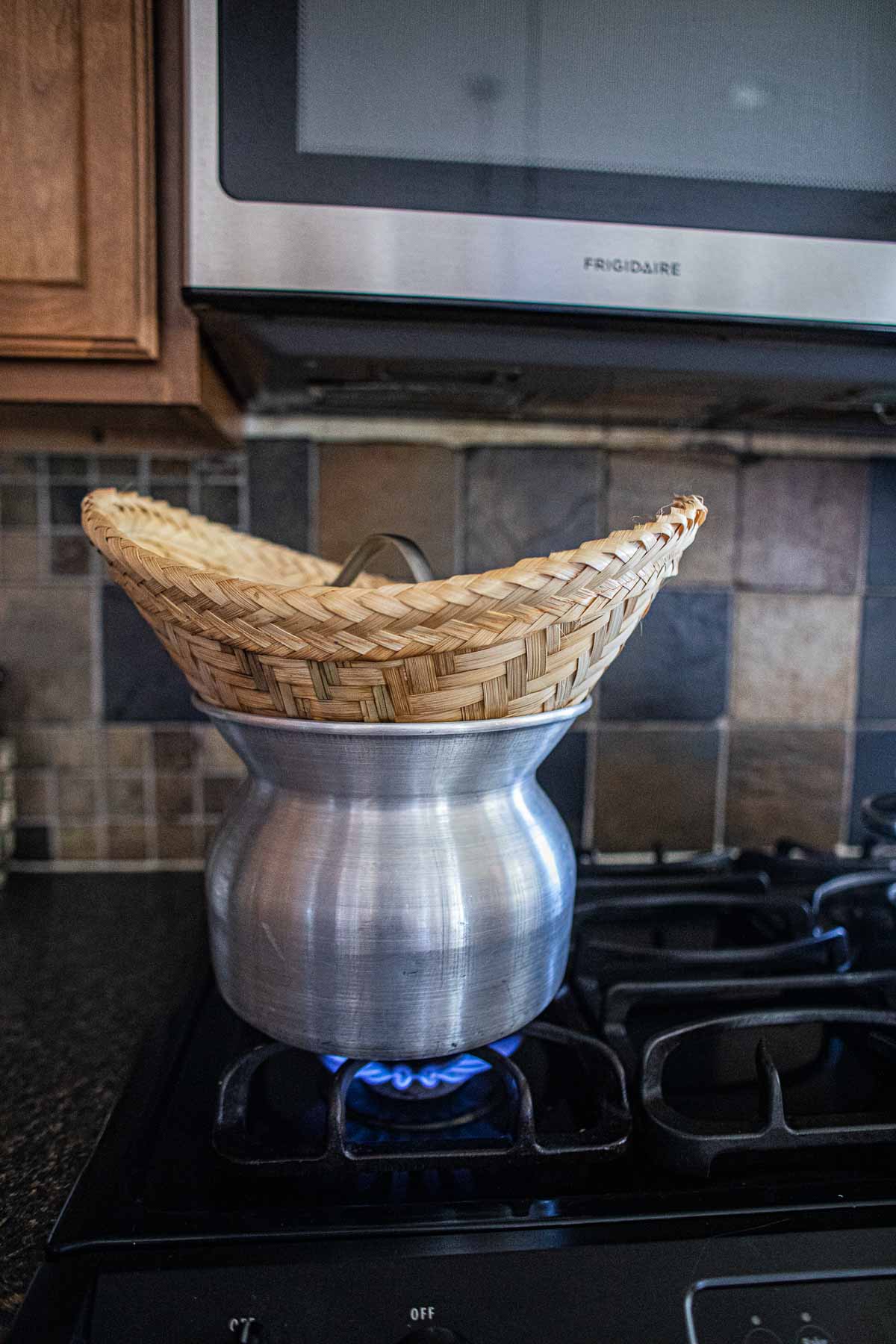
Step 5. Check your rice 15 minutes into the steaming. (Set your timer if it's helpful). If the rice looks translucent and shiny, carefully take a small piece of cooked rice with a long fork or wooden spoon to see how it tastes. Be very careful of the hot steam!
Step 6. The sticky rice should be cooked on the el dente side but not crunchy. If you love it, it's done. If not, cook for 5-10 more minutes. But this is the part I want you to be extremely careful about, especially if this is your first time making sticky rice. You're going to flip the rice.
Carefully remove the stackable steamer from the stainless steel pot, and open the cheesecloth carefully. It's going to be hot. Then slowly flip the rice until the rounded bottom part is on top. Use a fork or wooden spoon to fluff the rice to let moisture and steam evaporate so the rice is not mushy. Leave it briefly, then wrap the cheesecloth back on the rice.
Cover with the lid and place the bamboo basket back into the pot of water. Be careful of the boiling water.
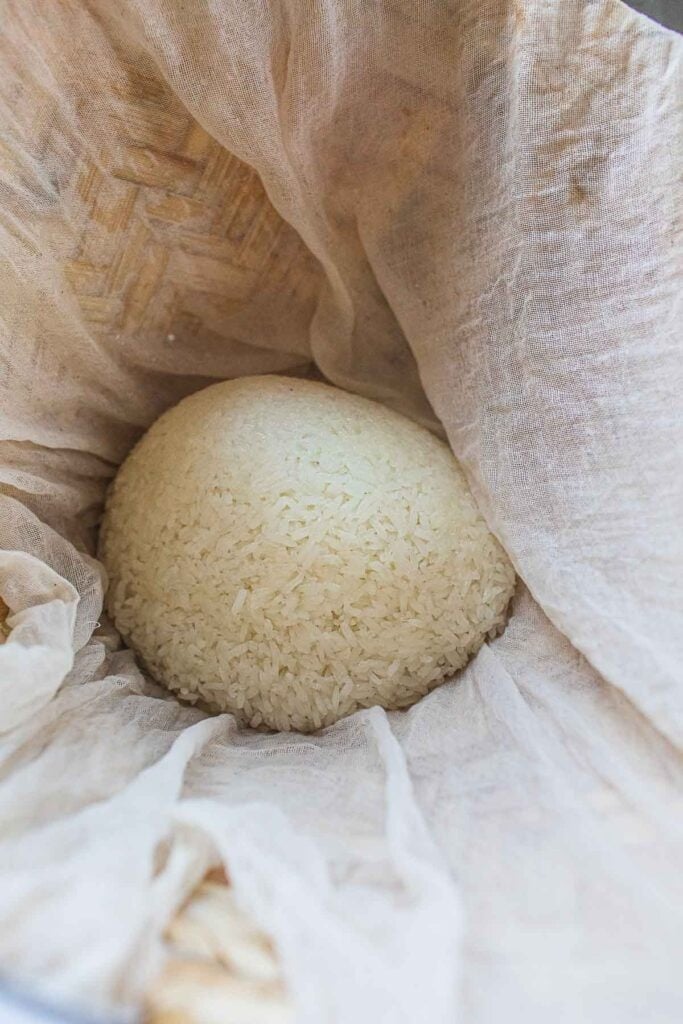
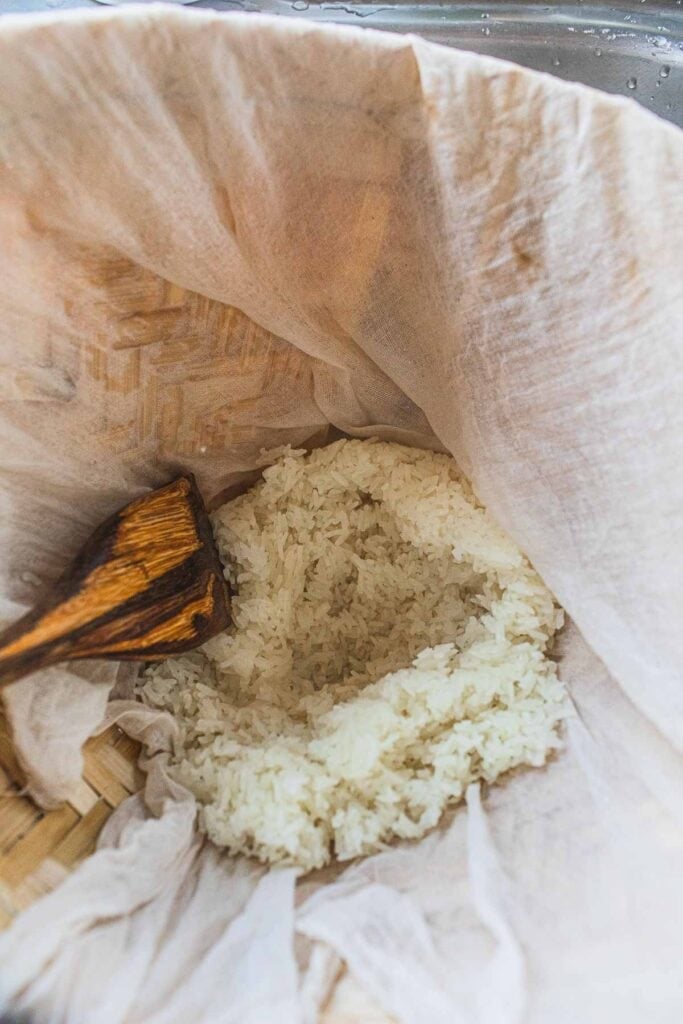
Step 7. Steam the rice for 5-10 more minutes until the rice is soft and chewy. Turn the heat off, remove the rice basket from the pot, and set it on a steaming rack or sink. Fluff the rice again and leave the cheesecloth open. Let it cool for a few minutes. Sprinkle salt on the rice if you prefer some.
Discard the excess water in the stainless steel pot.
Step 8. Place the cooked in another sticky rice basket, the kind used for serving rice as you might sometimes see at your favorite Thai restaurant.
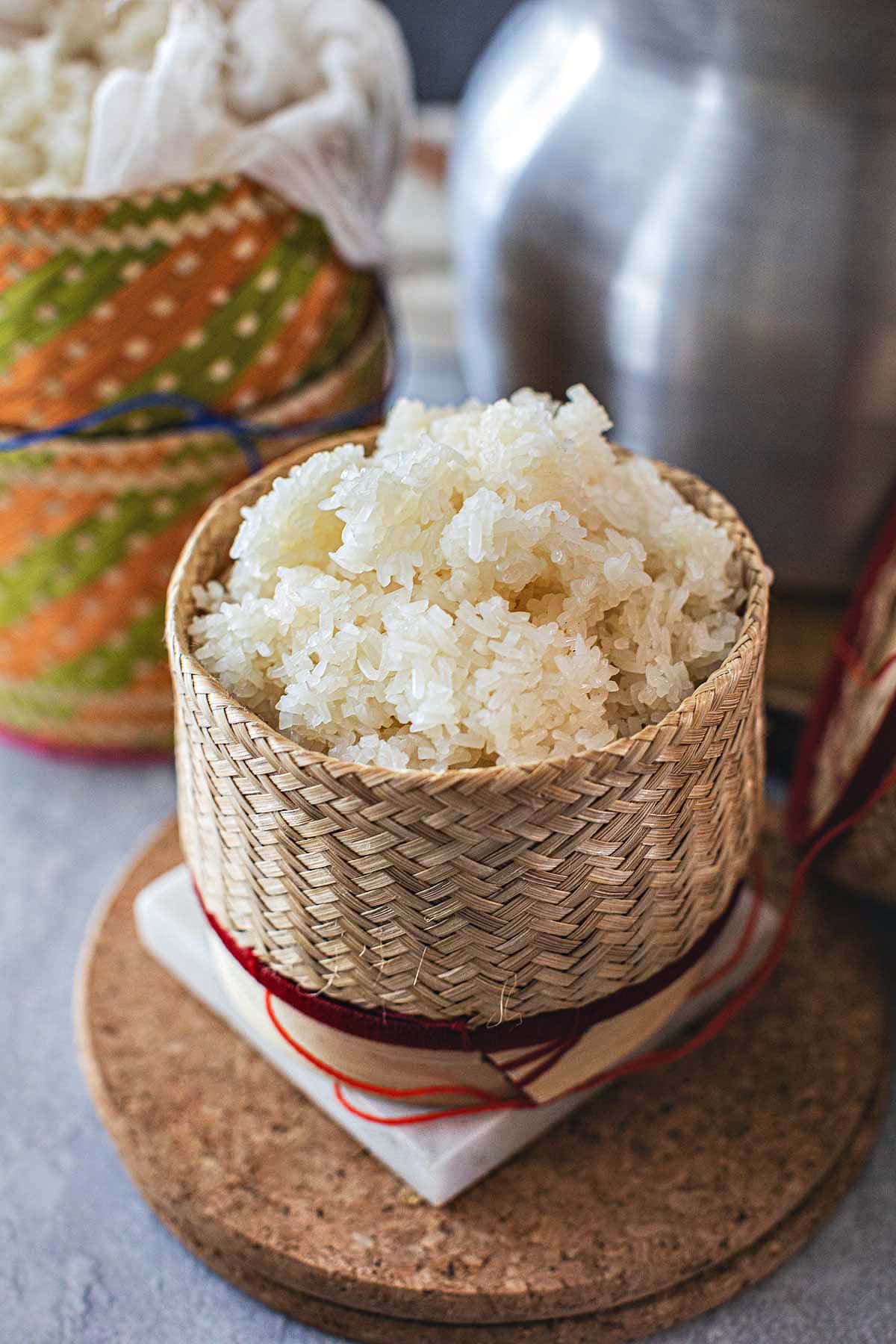
Tips for Making Sticky Rice
- Thai sticky rice MUST be soaked overnight before cooking. This step is crucial. The soaking will help soften the grains before steaming. At least 5 hours of soaking is recommended for the rice to achieve the proper consistency when steamed.
- Do not soak sticky rice longer than 24 hours, or the grains will start to get too soft and break into short-grain rice.
- To speed up the soaking process, use warm, NOT hot water, and cut the soaking time to 3.5 hours.
- The longer you soak the rice, the shorter the steaming time.
- Use a clear glass lid to cover the bamboo sticky rice steamer basket. It helps with seeing how the sticky rice is cooking.
- When flipping the sticky rice on step 6. Ensure at least a few inches of water are left from the bottom of your steamer. Add a cup or more if you run out of water for the remaining cooking time.
- You can fluff your cooked rice on a flat surface using baking sheets to allow the moisture to escape. Allow it to air for 5 minutes before placing the warm rice in a serving container.
Recipes using Steamed Sticky Rice
- Purple sticky rice
- Khao Khua, toasted rice powder used for seasoning sauces, salads, and soups.
- Nam Jim Jaeow, a spicy dipping sauce
- Mango sticky rice with sweet coconut milk sauce
- Thai coconut ice cream
What to serve with Thai Sticky Rice
These dishes are many Thai's favorite ways of pairing and eating sticky rice! Pick out one or two recipes and enjoy them with your freshly cooked Khao Neow!
- Laab Gai
- Som tom Thai
- Lao papaya salad
- Som Tum Tua
- Som Tum Tang
- Nam Tok
- Thai Beef salad
- Crying tiger
- Nam Jim Jaoew
Sticky Rice Thai variations
- Japanese sweet rice is another type of glutinous rice. It's not the same thing as Thai sticky rice, but it will be cooked to the same consistency. It has shorter grains than Thai sticky rice.
- There is no substitute for Thai sticky rice. However, two other types of rice are sticky and can be used to make sticky rice. Japanese sweet rice, a shorter grain of rice, and black sticky rice. Black sticky rice (red or purple sticky rice) is dark, whole-grained rice mixed with white sticky rice to make purple rice.
How to store Steamed Sticky Rice
- Store your cooked sticky rice in a small sticky rice basket with the lid on. Leave the rice at room temperature for up to 3 days if your house is not too hot.
- You may have seen some Thai restaurants where they use plastic wrap inside the bamboo basket to keep the rice in to keep the basket clean. Use wax paper instead, it's safer, and you can throw away the sheet when finished with your rice.
- If you don't have a sticky rice basket holder, store your rice in aluminum foil and fold it neatly to keep it soft. Keep at room temperature for up to 2 days.
- Store your leftover sticky rice in an air-tight container but do not refrigerate it. Keep at room temperature for 2-3 days only.
Reheating sticky rice
- To reheat your sticky rice, follow the same steps to steam sticky rice minus the soaking part. Steam the leftover in a steamer for a few minutes, or use a metal strainer over a pot of water. Steam for only a few minutes until the rice is soft again.
- Microwave the rice is not recommended as the rice will dry out almost completely and the grains fall apart rather than getting soft and sticky.
Frequently Asked Questions
This is due to plants' low amount of Amylose and starch properties. Instead, Sticky rice has a high amount of Amylopectin, the other starch properties in plants that make food like glutinous rice, potatoes, cassava (think tapioca starch), wheat, and some root vegetables. Read more about the scientific terms of how rice works here.
Yes. Like most rice, sticky rice needs to be washed a few times with water until the water is mostly clear to remove the cloudy starch so the rice cooks and tastes better.
NO. Jasmine rice is not the same as sticky rice. It doesn't have the look or texture of cooked or uncooked. Sticky rice grains are milky white in color and have a slightly thicker grain than Jasmine rice.
Sticky rice also requires absorption of water, by soaking it, for a few hours to soften the grains before it's steamed, not boiled for cooking. Jasmine rice, on the hand, doesn't need soaking and can be cooked directly with water in a rice cooker or pot.
Cooked Sticky rice can be eaten as a side dish or a fun snack. Once cooked, the rice grains will stick together (thus the name "sticky rice"). Roll the rice into golfball pieces and use your fingers to eat it plain, with a small sprinkle of salt or dip it in sauces, condiments, or sauces.
Cooked Sticky rice has a soft, chewy texture with a very light natural sweetness mixed with a gently nutty flavor that is extremely pleasant and addictive, especially when freshly cooked from a steamer.
There are various ways to make sticky rice. Sticky rice can be made with kitchen tools using high-pressure cooking like an instant pot pressure cooker and microwave. It can also be made in an electric steamer because sticky rice is typically best steamed. But this traditional bamboo basket method is the best, followed by the pot steamer.
Shushi rice and sticky rice are similar, but there are major differences. Thai Sticky rice requires hours of soaking before steaming in a steamer and is used as a side dish, making desserts, or making various recipes. Shushi rice is a Japanese short-grained rice used to make sushi and desserts in Japanese cuisine.
It is different from other types of rice used in Thai cooking. It is important to know the right type of rice to use. Sticky rice must be soaked in water for at least 4 hours before it's steamed, not cooked. In the traditional method of cooking sticky rice, water never touches the grains once on the stovetop. You can easily tell sticky rice apart because other types of rice do not have the obvious glue-like texture of sticky rice once cooked.
- Sweet rice
- Thai Glutinous rice
- Khao Neow
- Khao Niew
- Kao Niew
- Kao Nieo
Find your sticky rice at your local Asian markets. Most stores will have them.
Grab them online at Amazon. Here are the brands I recommend. Three Rings brand, Cock on the mountain top brand, and Three Ladies Santapong brand.
How do you clean a sticky rice bamboo basket and steamer?
To clean the bamboo sticky rice basket set, wash the stainless steel steamer with water and soap, rinse, wipe dry with a kitchen towel, or let it air dry on a dish rack.
For the bamboo steaming basket, do not use soap to wash it. Use a quick rinse of warm water to wash and lightly scrape any sticky rice grains off the basket's sides. Air dry completely before putting it back in storage, or the bamboo straws will get moldy from the wet moisture.
For the bamboo basket rice holder. Clean it the same way as the basket steamer. Do not use soap, as the soap residues can get trapped in the basket and interfere with the flavor of the rice the next time you use it.
Hand washing is always the best for the bamboo sticky rice set. The stainless steel pot is too big for the dishwasher.
Best to clean your sticky rice basket right away while the rice grains are still soft from the steam. They are easier to scrape off while warm.
More Thai savory dishes you'll love
- Pad Kee Mao
- Pad Mee Korat
- Thai basil fried rice
- Simple Pad mee, vermicelli rice noodles
- Spicy basil fried rice
Love a recipe you've tried? Please leave a 5-star ?rating in the recipe card below and/or a review in the comments section further down the page. Or follow me on Facebook, Pinterest, or Instagram!
Print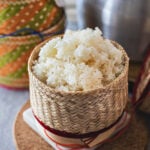
Sticky Rice Bamboo Steamer Recipe
- Total Time: 5 hours 25 minutes
- Yield: 6
- Diet: Vegan
Description
Learn how to make Thai sticky rice in a bamboo steamer, traditionally using a steamer pot and a bamboo steamer basket. This method is the aged-old, proven, and true method that Thai people have used in Thailand for generations. Master the art of making this iconic rice that is popular worldwide!
Ingredients
- 2 cups sticky rice, uncooked
- 8-10 cups water. If your pot is larger, you may need more water.
- Salt. Optional. For added to cooked rice
Instructions
- First thing first. Wash the sticky rice. In a mixing bowl, add the rice and cool water to wash and rinse. Use your fingers to swoosh the rice grains in the water to help loosen up the grains and starch. Your water will be cloudy, milky water. Rinse the water out and repeat this step 4-5 times until your water is mostly clear. Use a strainer or splatter guard to catch the rice grains when pouring if you don't want to lose rice grains. Soak the rice in cold water for a minimum of 5 hours at room temperature up to overnight for the best result. No longer than 24 hours. See the note below for more kitchen tips.
- Next, steam the rice the next day or a few hours after it's been soaked. Fill the bottom of the steamer pot with enough water to steam rice for up to 20-25 minutes without the water drying out. So anywhere from 8-12 cups, depending on the size of your pot. The large pot will require more water and also cooking time. The water level should be low enough not to let the bottom of the bamboo basket touch it. Allow at least 2 inches of space between the water and the bamboo basket.
- Wash, drain, and rinse the soaked rice before steaming. Then line the bamboo basket with cheesecloth, and place the rinsed rice over the cloth. Wrap the cheesecloth around the rice grains, place the basket over the stainless steel pot then cover it with a lid before steaming.
- Place the stainless steel with water inside and the cheese-clothe-covered rice in the bamboo basket. Turn the stovetop to high heat and cook for 15-20 minutes. It takes longer (20-25 minutes) if you soak your rice for less than 5 hours.
- Check your rice 15 minutes into the steaming. (Set your timer if it's helpful). If the rice looks translucent and shiny, carefully take a small piece of cooked rice with a long fork or wooden spoon to see how it tastes. Be very careful of the hot steam!
- The sticky rice should be cooked on the el dente side but not crunchy. If you love it, it's done. If not, cook for 5-10 more minutes. *But this is the part I want you to be extremely careful about, especially if this is your first time making sticky rice*. You're going to flip the rice. Carefully remove the basket steamer from the stainless steel pot, and open the cheesecloth carefully. It's going to be hot. Then slowly flip the rice until the rounded bottom part is on top. Use a fork or wooden spoon to fluff the rice to let moisture and steam evaporate so the rice is not mushy. Leave it briefly, then wrap the cheesecloth back on the rice. Cover with the lid and place the bamboo basket back into the pot of water. Be careful of the boiling water.
- Steam the rice for 5-10 more minutes until the rice is soft and chewy. Turn the heat off, remove the rice basket from the pot, and set it on a steaming rack or sink. Fluff the rice again and leave the cheesecloth open. Let it cool for a few minutes. Sprinkle salt on the rice if you prefer some. Discard the excess water in the stainless steel pot.
- Place the cooked in another sticky rice basket, the kind used for serving rice as you might sometimes see at your favorite Thai restaurant. That's it! ENJOY your sticky rice! You did it!
Notes
- Thai sticky rice MUST be soaked overnight before cooking. This step is crucial. The soaking will help soften the grains before steaming. At least 5 hours of soaking is recommended for the rice to achieve the proper consistency when steamed.
- Do not soak sticky rice longer than 24 hours, or the grains will start to get too soft and break into short-grain rice.
- To speed up the soaking process, use warm, NOT hot water, and cut the soaking time to 3.5 hours.
- The longer you soak the rice, the shorter the steaming time.
- Use a clear glass lid to cover the bamboo sticky rice steamer basket. It helps with seeing how the sticky rice is cooking.
- When flipping the sticky rice on step 6. Ensure at least a few inches of water are left from the bottom of your steamer. Add a cup or more if you run out of water for the remaining cooking time.
- You can fluff your cooked rice on a flat surface using baking sheets to allow the moisture to escape. Allow it to air for 5 minutes before placing the warm rice in a serving container.
- ** Thank you so much for visiting my blog! This is truly a passion for me. If you have enjoyed these recipes and appreciate the hard work I put into them, I would love it if you would share them with your friends! Your recommendation is the highest review I could hope for, and I’d appreciate it! **
- Prep Time: 5 Hours
- Cook Time: 25 Minutes
- Category: Rice
- Method: stovetop, steamed, boiling
- Cuisine: Thai

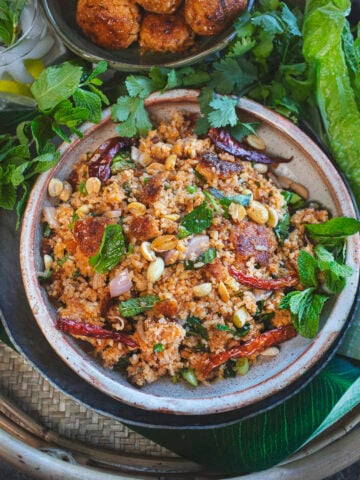
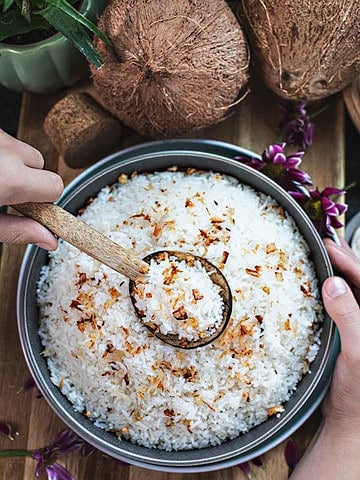
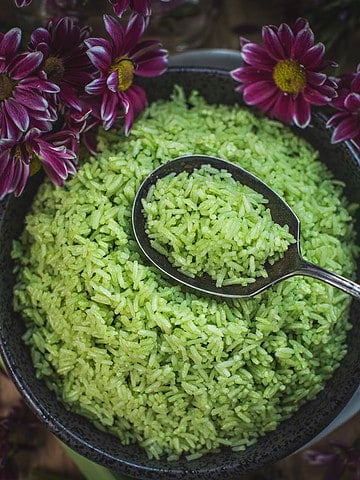
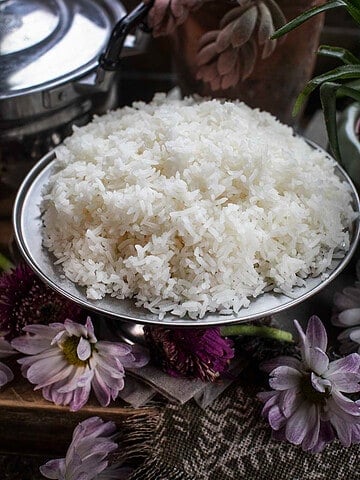
Cassie says
Love learning new ways to make more authentic food! Thank you!!
Anne says
Perfect instructions!
Lizie says
Thai sticky rice is amaZing!
Suwanee says
Detailed information on how to make Thai sticky rice the traditional way.